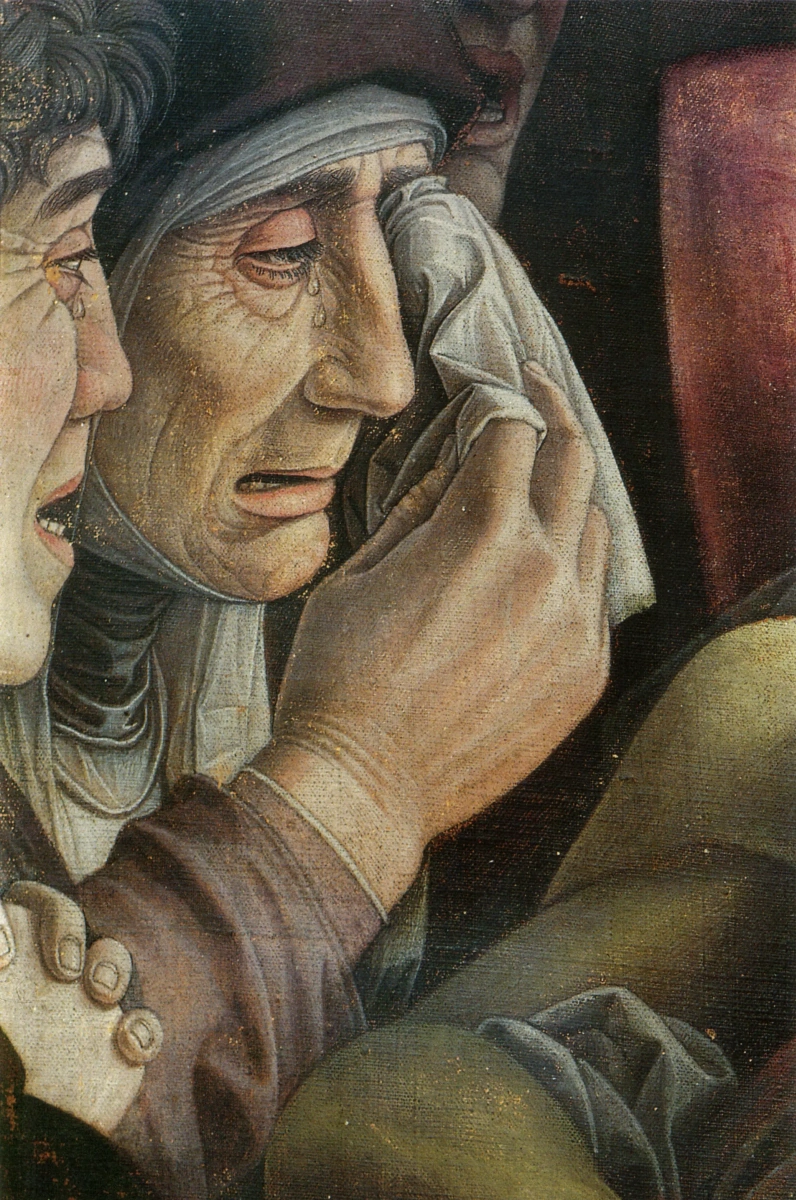увійти
Увійдіть на сайт
Залогіньтесь, щоб використовувати максимум функцій Артхіва
Мертвый Христос (Оплакивание мертвого Христа)
Андреа Мантенья • Живопис, 1483, 81×66 см


















Опис картини «Мертвый Христос (Оплакивание мертвого Христа)»
Хранящееся в миланской Пинакотеке Брера «Оплакивание мертвого Христа» - не только самая известная картина Андреа Мантеньи, но и одна из самих необычных в мировой живописи.
В чём её необычность?
Во-первых, в композиции. Пятки Христа касаются нижней кромки картины, а голова почти упирается в верхнюю. В таком размещении тела на холсте не было бы ничего особенного, если бы это была фронтально располагающаяся фигура – стоящая или сидящая. Иное дело – изобразить лежащее тело перпендикулярно горизонтальной оси. Мантенье пришлось прибегнуть к чрезвычайно резкому перспективному сокращению и выбрать очень низкую точку зрения. И сделал он это с виртуозным правдоподобием: здесь сказываются его прилежные штудии трактатов по перспективе, геометрии и оптике.
Во-вторых, необычность «Оплакивания мёртвого Христа» Мантеньи в натуралистичности. Вопреки своему пиетету перед античностью с её культом героев и идеальных красавцев, Спасителя Мантенья изображает нарочитым простолюдином. Об этом говорят его угловатое лицо, широкая крестьянская грудь, заскорузлые натруженные ступни. Подобным же образом Дева Мария на картине «Мадонна с Младенцем, Иоанном Крестителем и Марией Магдаленой» наделена миловидным, но рябым и подслеповатым лицом крестьянки. Еще яснее эта тенденция в картине «Христос, несущий крест».
Очевидно, в этом упорном нежелании аристократизировать «Царя иудейского» заключалась принципиальная позиция художника. Тем самым Андреа, сын падуанского дровосека, приближает Иисуса, сына вифлеемского плотника, к сирым и убогим – к кому, собственно, Христос (во времена Мантеньи окончательно монополизированный Ватиканом) и пришёл.
Страсти по «Оплакиванию мёртвого Христа»
Известно, что эта картина была очень дорога Мантенье и хранилась в его доме до самой смерти художника. Предполагается, единственное сохранившееся до нашого времени «Оплакивание мертвого Христа» – это авторская копия, а оригинал утрачен.
Уже в наши дни настоящие сражения за картину развернулись между Миланом и Мантуей. В 2006-м году, когда отмечалось 500 лет со дня смерти художника, центром торжеств должна была стать Мантуя, где Мантенья работал и жил большую часть своей жизни и где он погребён. Однако Пинакотека Брера в Милане отказалась предоставить «Оплакивание мертвого Христа» для мантуанской выставки. Возник крупный скандал, который вынужден был решать тогдашний министр культуры Италии Франческо Рутелли. В результате миланским специалистам удалось доказать, что темпера на холсте Мантеньи слишком хрупка и не переживёт транспортировки даже в близлежащую Мантую. Впрочем, нельзя исключить, что дело здесь не сохранности шедевра, а в пресловутом культурном соперничестве североитальянских городов.
Визуальная цитата из Мантеньи в фильме Андрея Звягинцева
Картина продолжает будоражить умы и сейчас.
Например, на 10-й минуте фильма Андрея Звягинцева «Возвращение» мы можем увидеть прямое цитирование «Оплакивания мёртвого Христа». Сыновья-подростки впервые видят спящего отца, вдруг ниоткуда возникшего в их жизни. Он лежит на кровати в той же позе и снят с того же низкого ракурса, в котором написан Христос Мантеньи. Звягинцев ставит фильм-притчу, и этой недвусмысленной цитатой, очевидно, закрепляет параллель между отцом и Богом: оба суровы и непреклонны, оба вмешиваются в жизнь человека, когда их меньше всего ждут, оба диктуют сыновьям свою волю и оба до конца не постижимы.
Автор: Анна Вчерашняя
В чём её необычность?
Во-первых, в композиции. Пятки Христа касаются нижней кромки картины, а голова почти упирается в верхнюю. В таком размещении тела на холсте не было бы ничего особенного, если бы это была фронтально располагающаяся фигура – стоящая или сидящая. Иное дело – изобразить лежащее тело перпендикулярно горизонтальной оси. Мантенье пришлось прибегнуть к чрезвычайно резкому перспективному сокращению и выбрать очень низкую точку зрения. И сделал он это с виртуозным правдоподобием: здесь сказываются его прилежные штудии трактатов по перспективе, геометрии и оптике.
Во-вторых, необычность «Оплакивания мёртвого Христа» Мантеньи в натуралистичности. Вопреки своему пиетету перед античностью с её культом героев и идеальных красавцев, Спасителя Мантенья изображает нарочитым простолюдином. Об этом говорят его угловатое лицо, широкая крестьянская грудь, заскорузлые натруженные ступни. Подобным же образом Дева Мария на картине «Мадонна с Младенцем, Иоанном Крестителем и Марией Магдаленой» наделена миловидным, но рябым и подслеповатым лицом крестьянки. Еще яснее эта тенденция в картине «Христос, несущий крест».
Очевидно, в этом упорном нежелании аристократизировать «Царя иудейского» заключалась принципиальная позиция художника. Тем самым Андреа, сын падуанского дровосека, приближает Иисуса, сына вифлеемского плотника, к сирым и убогим – к кому, собственно, Христос (во времена Мантеньи окончательно монополизированный Ватиканом) и пришёл.
Страсти по «Оплакиванию мёртвого Христа»
Известно, что эта картина была очень дорога Мантенье и хранилась в его доме до самой смерти художника. Предполагается, единственное сохранившееся до нашого времени «Оплакивание мертвого Христа» – это авторская копия, а оригинал утрачен.
Уже в наши дни настоящие сражения за картину развернулись между Миланом и Мантуей. В 2006-м году, когда отмечалось 500 лет со дня смерти художника, центром торжеств должна была стать Мантуя, где Мантенья работал и жил большую часть своей жизни и где он погребён. Однако Пинакотека Брера в Милане отказалась предоставить «Оплакивание мертвого Христа» для мантуанской выставки. Возник крупный скандал, который вынужден был решать тогдашний министр культуры Италии Франческо Рутелли. В результате миланским специалистам удалось доказать, что темпера на холсте Мантеньи слишком хрупка и не переживёт транспортировки даже в близлежащую Мантую. Впрочем, нельзя исключить, что дело здесь не сохранности шедевра, а в пресловутом культурном соперничестве североитальянских городов.
Визуальная цитата из Мантеньи в фильме Андрея Звягинцева
Картина продолжает будоражить умы и сейчас.
Например, на 10-й минуте фильма Андрея Звягинцева «Возвращение» мы можем увидеть прямое цитирование «Оплакивания мёртвого Христа». Сыновья-подростки впервые видят спящего отца, вдруг ниоткуда возникшего в их жизни. Он лежит на кровати в той же позе и снят с того же низкого ракурса, в котором написан Христос Мантеньи. Звягинцев ставит фильм-притчу, и этой недвусмысленной цитатой, очевидно, закрепляет параллель между отцом и Богом: оба суровы и непреклонны, оба вмешиваются в жизнь человека, когда их меньше всего ждут, оба диктуют сыновьям свою волю и оба до конца не постижимы.
Автор: Анна Вчерашняя



